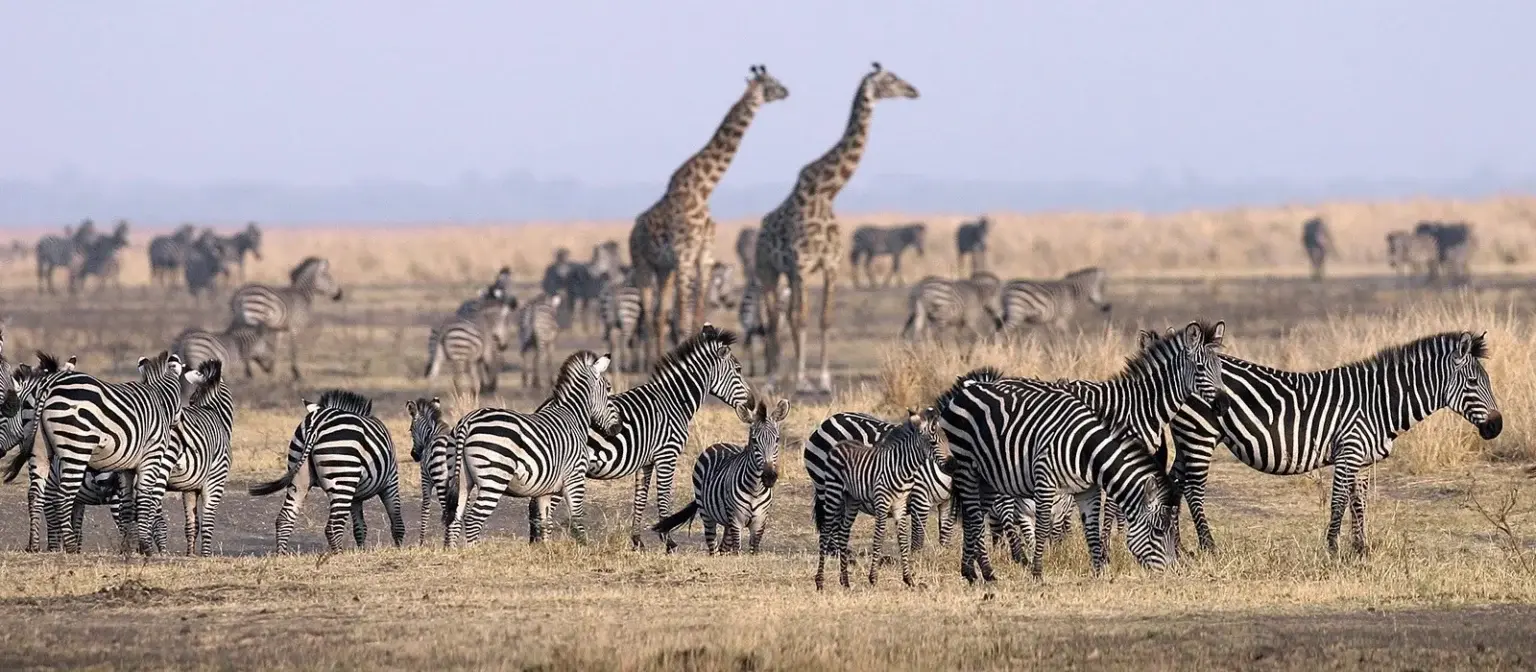Northern Tanzania Safaris
What Makes Northern Tanzania Safaris Some Of The Best In Africa
The Northern Tanzania Safari Circuit is by far the most popular and busiest, especially during peak safari season (June to October). This circuit includes some of the most famous and iconic places in all of Africa — destinations you’ve seen in nature documentaries, travel shows, and films. For first-time visitors, this is the perfect starting point. The northern circuit has some of the best roads in Tanzania, so it’s easier and faster to travel between parks. There are also plenty of accommodation options — from budget-friendly campsites to some of the most luxurious lodges on the continent.
The northern Tanzania circuit stretches from Lake Victoria in the west to Mt Kilimanjaro in the east. It runs from the Kenyan border in the north down to Tarangire National Park in the south. It includes world-famous places like the Serengeti and the Ngorongoro Conservation Area. These areas are so rich in wildlife and scenery that they deserve more of your time to truly enjoy them.
Best Northern Tanzania Safaris
Reasons To Visit Northern Tanzania
1. Serengeti National Park
Serengeti is one of Africa’s most famous safari destinations. It covers a huge area—about 5,700 square miles—and is full of amazing wildlife and beautiful scenery all year round.
You’ll find open grasslands, rivers, forests, and woodlands, making the landscape rich and varied. The park is home to lots of animals, including the “Big Five”. It’s also a great place for bird lovers, with over 500 species. There are many safari lodges to choose from, whether you’re on a budget or looking for luxury. These lodges let you stay close to nature and enjoy the sights and sounds of the Serengeti.
Each season brings something special. From June to October, head to the northern Serengeti to witness the famous wildebeest migration. You might even see dramatic Mara River crossings, where the animals leap into crocodile-filled waters—a thrilling sight! From January to March, the action moves to the southern Serengeti during calving season, when thousands of baby wildebeest and zebras are born.
This also attracts many predators like lions and cheetahs, so it’s an exciting time for wildlife photography. No matter when you visit, the Serengeti offers unforgettable wildlife encounters, stunning landscapes, and the magic of nature at its best.
2. The Great Wildebeest Migration
The Great Wildebeest Migration is one of the most amazing wildlife events on Earth. Every year, millions of wildebeest and zebras travel across the wide-open plains of Tanzania and Kenya, moving in a big circle in search of fresh grass and water. This journey takes them between the southern Serengeti and Kenya’s Masai Mara, and it never stops—it goes on all year round.
From December to March, the herds gather in the southern Serengeti and the nearby Ngorongoro Conservation Area. This is calving season, when thousands of baby wildebeest are born each day. It’s a beautiful sight—but also a dangerous one, as predators like lions and hyenas are always nearby, looking for an easy meal.
From July to October, the herds group together in the northern Serengeti, getting ready to cross the Mara River into Kenya. These river crossings are thrilling to watch—fast, chaotic, and full of danger. Crocodiles wait in the water, and the wildebeest must be brave and strong to make it across. Throughout the migration, there’s never a dull moment. You can see incredible scenes of animals running, hunting, and surviving in the wild. Make sure your camera is ready—this is a once-in-a-lifetime experience you won’t want to miss!
2. Tarangire National Park
Tarangire is a special place in Tanzania, known for its huge herds of elephants and its amazing baobab trees. These giant trees look like something from another world, standing tall and proud across the landscape.
You’ll also see sunbaked termite mounds popping up like little clay mountains, adding to the park’s unique beauty. From June to November, during the dry season, Tarangire becomes one of the best places in the world to see elephants. Hundreds of them gather here, along with buffalo, wildebeest, zebras, and many predators like lions, leopards, cheetahs, and hyenas. It’s an amazing time to visit and see wildlife up close.
At the heart of the park flows the Tarangire River—a lifeline for animals, especially in the dry months. The river winds its way through the park and into the Silale Swamp, creating a year-round water source. This swamp attracts a huge variety of animals, making it a perfect place for game viewing. If you love nature, wild animals, and peaceful scenery, Tarangire is a must-see destination.
4. Ngorongoro Crater
Ngorongoro Crater is a natural wonder and a UNESCO World Heritage Site. It’s the world’s largest unbroken and unflooded volcanic crater, and one of the best places in Africa to see wild animals in their natural home.
Inside the crater, you can spot the Big Five—lion, leopard, elephant, buffalo, and the rare black rhino, known for its sharp horns and hooked lip. The crater is packed with wildlife, including huge herds of wildebeest, zebra, gazelle, and many predators like lions and hyenas.
Animals are easy to spot here because they stay inside the crater, where food and water are always available. Your safari will take you down the steep crater walls to the flat floor below, where the adventure begins. This is a perfect place for wildlife viewing and photography.
At lunchtime, you can relax under a shady acacia tree and enjoy a picnic surrounded by nature. You might even have some curious company—hippos, playful monkeys, or yellow-billed kites flying above, keeping an eye on your food! A visit to Ngorongoro is like stepping into a wildlife movie—breathtaking, unforgettable, and full of surprises.
5. Mount Kilimanjaro
Climbing Mount Kilimanjaro, the highest mountain in Africa and the tallest free-standing mountain in the world, is a once-in-a-lifetime adventure. There are seven main routes to the summit—Marangu, Machame, Umbwe, Rongai, Shira, Lemosho, and the Northern Circuit. Each route offers its own unique experience and challenges, making the journey exciting and memorable.
To reach the top successfully, it’s very important to let your body adjust slowly to the high altitude. This process, called acclimatisation, is key to staying healthy and making it to the summit. Among all the options, two of the best routes for a safe and enjoyable climb are the Rongai and Lemosho routes. The Rongai Route begins on the quiet northern side of the mountain. It is peaceful and less crowded, passing through remote forests where you might spot animals like antelope, elephants, buffalo, colobus monkeys, and many birds.
On the other hand, the Lemosho Route is a newer and longer trail that takes you through many different landscapes, from lush rainforest to dry alpine zones. It’s known for its beautiful views and gives climbers more time to adjust to the altitude, which increases the chances of reaching the summit.
When choosing your route, consider your fitness level, how much time you have, your budget, and the kind of experience you want. Pick a path that allows your body to adjust gradually, avoids busy trails, and gives you the chance to enjoy Kilimanjaro’s stunning scenery every step of the way.
6. The Maasai
The Maasai are a proud and fascinating group of people who live mainly in Kenya and Tanzania. They are known around the world for their colourful clothing, strong traditions, and unique way of life. Their history goes back hundreds of years, with roots in the Nile Valley of Sudan.
The Maasai are pastoralists, meaning they raise animals like cattle, goats, and sheep. Livestock is very important to them—it provides food, shows wealth, and plays a big role in their culture. Their society is organised by age groups, and each group has its own duties. Young men, called morans, are trained to become warriors. In the past, these warriors protected their people and animals from danger and even resisted colonial rule with great courage.
While on safari, you may have the chance to meet the Maasai and learn more about their way of life. You might visit a Maasai village, see their traditional dances and ceremonies, and hear their stories. These visits help support the community and allow you to experience a culture that is both ancient and alive today. Take the time to connect with the Maasai, and you’ll discover a people full of strength, warmth, and deep respect for nature and tradition.
7. Lake Manyara National Park
The best time to visit Lake Manyara is during the dry season, from June to October. During this time, the thick greenery clears, and you can enjoy clear views of the beautiful soda lake and the many animals that live nearby. Lake Manyara sits between Tarangire and Ngorongoro, making it a perfect stop on your safari. The lake shines under the sun, surrounded by the steep cliffs of the Great Rift Valley, adding to its beauty.
Lake Manyara is full of life, with many different landscapes packed into one small area. You’ll see everything from thick forests and open grassy plains to large, ancient baobab trees. It’s like a small version of all of Africa’s wild habitats in one place. For bird lovers, the wet season from November to May is the best time to visit. That’s when the lake fills up with water, and flamingos arrive in large numbers.
These lovely pink birds gather in the shallow waters to feed and breed, creating a magical sight along the lake’s edge. As you explore the park, you might also see huge herds of elephants, along with the park’s most famous residents—tree-climbing lions, a rare and amazing sight in the wild. Lake Manyara may be small, but it offers big beauty, rich wildlife, and unforgettable moments.

How To Get Around On A Northern Safari Circuit In Tanzania
Safari travellers can explore the wide and beautiful landscapes of the Northern Circuit using pre-arranged road transfers on good roads. Since the parks are close together, driving is a comfortable and popular way to travel. For those who want to save time, light aircraft flights are a great option. These short flights quickly connect one park to another, so you can spend more time on safari and less time sitting in a car.
Best Time For Northern Tanzania Safaris
The best time for a safari in Northern Tanzania is during the dry season, from June to October. During these months, all the well-known parks offer amazing wildlife experiences. One of the most unforgettable sights is the wildebeest river crossings in the northern Serengeti. Watching thousands of animals cross the Mara River is one of the most exciting and popular safari moments.
As the dry season continues, animals gather around the few remaining water sources, making it easier to spot them and enjoy some of the best game viewing of the year.
From December to March, the migration moves to the southern Serengeti plains for the calving season. This is when thousands of baby wildebeest are born, and it attracts many predators like lions and cheetahs, leading to dramatic wildlife scenes and plenty of action.
Our Trusted Partners






